Let's do the compact history of the role playing game and by extension the history of games and modeling.
It begins with classic mythology, the origin stories of cultures. Some of the mythology dating back thousands upon thousands of years in the Middle East, Africa and China. One of the oldest written stories being that of Gilgamesh, a hero and king that introduces the world to the idea of spirit orders and natural law. Religious text soon followed and spread throughout the world. Some of the spoken traditions from foreign cultures became intertwined with literature. The mix was a way to introduce Christian ideals to Pagan cultures. The poem Beowulf is an example of that.
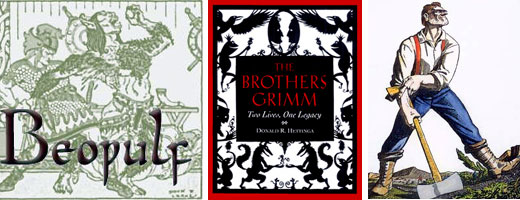
All throughout the various cultures and peoples there were myths and heroes, folklore and legends. From King Arthur and the Knights of the Round Table to tall tales about Paul Bunyan. Some of these stories gave rise to fairy tales, the Brothers Grimm being associated closely with the creation or adaptation of various legends. Almost a hundred years later, on a bet, JRR Tolkien and CS Lewis created themed stories based on classic fantasy characters. The Lord of the Rings and the Chronicles of Narnia read like fantasy anthologies. Even if you have never read the books who among us does not know about elves, dwarfs, dragons, goblins and orcs? We know what they look like, how their society works and who their allies are. We know this because the template was presented in the works of Lewis and Tolkien, it has remained relatively unchanged since that time.
If you've seen the Lord of the Rings movie you should have noticed several things. It begins with a simple story and archetypical characters. Eventually they must embark on a quest filled with dangerous battles and exotic locations. Along the way the characters are aided by new friends and magical weapons. Count the items that the main character, Frodo, picks up along his adventure. A ring, cloak, armor, sword and a magical vial. Each of these items are used at different intervals. Each of these items are crucial to completing the quest. Stop and think about how this formula has been used in games. Does Zelda or Final Fantasy come to mind? What about God of War or Metal Gear Solid? Link, Solid Snake, Kratos, they all need something. To beat their quest they must learn new techniques, obtain keys, armor or weapons. The template has not changed much.
This is just the cusp of the role playing genre, we have to go on a tangent, to look at how stories became games.
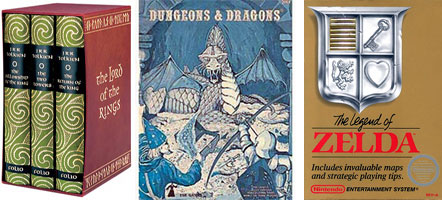
Before there were videogames there were hobby games. The one directly influenced by all of the literature I've mentioned is Dungeons & Dragons. First published in the year of my birth, 1974, the game allowed fans of the fantasy world to create a character (an avatar) and choose their own adventures. Many of the creatures and hero archetypes featured in the Tolkien and Lewis books were mirrored in the game and helped solidify the fantasy world. As influential as D&D was and is to modern RPG videogames it was not the only influence.
Literature has a lot to do with culture but so do traditional games. Some of the games we play use our body, a test of athleticism or skill, those of strategy use our mind and wits. Aside from early card and dice games, some of the oldest strategy games like Chess, Go and Shogi define modern civilization. These can also be considered the predecessors to board games.
Some of the strategy games were developed around popular battles or inspired by romantic ideals. The campaigns of early Rome all the way to Napoleon have influenced many types of games including chess and its variants. War is a popular genre because it directly affects culture, science, art, politics and history. War is romanticized in literature, what boy doesn't want to grow up to be a hero? Statues and monoliths dedicated to Julius Caesar are still standing. Today there are videogames based on modern conflicts, where we play the part of the liberator, the hero. How many videogames have been released based on WWII? Traditional games based on the campaigns of great generals are sometimes played with painted miniatures.
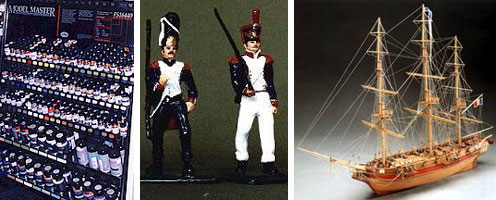
This brings me to the third idea, model making and its influence on the role playing game. The painted miniature, ranging in scale from a half inch to
three inches in height is a staple of model craft. Of course statues cast in bronze or sculpted from clay and stone have been a part of our culture for thousands of years, the idea of model-making for pleasure or business is not as old. Ships in bottles, carvings in ivory, wooden toys, castings of tin soldiers are seen as a craft, a hobby rather than an art form. This hobby has given birth to several industries. Hobbyists can be model makers, sculptors or painters, sometimes all three. Models require certain types of paints and brushes, the paints that work on canvas might not work on lead, pewter or plastic. The evolution of acrylics can be credited to the artisans creating dioramas and painting hundreds if not thousands of miniatures.

What happens when we combine the three genres? What happens if we merge the fantasy template with the strategy game and miniature modeling?
Miniature wargaming is a hobby. Like all hobbies it is something that requires a lot of time, patience and money to get involved with. Some people collect stamps, coins, Barbies or Transformers. Some people build scale railroads complete with scenery and working signals. These hobbyists spend time cataloging, restoring and building their collections. They hang out on weekends with local groups to talk shop. They go to conventions to meet like-minded people and purchase goodies. Videogames are a luxury, relatively speaking. Videogame stores are in every mall, the games themselves in every Wal-Mart or Target. Scoring a videogame doesn't usually require much hunting for specialty stores. Best of all you can get in and out of an adventure in a few minutes. God of War can teleport you to ancient Greece, Final Fantasy to Van'a'diel within a minute. Each game allows you to grind away and gain experience for a few minutes or a few hours. Both games allow you to have some fun and then be back in time for dinner. Mini wargaming takes a bigger commitment.
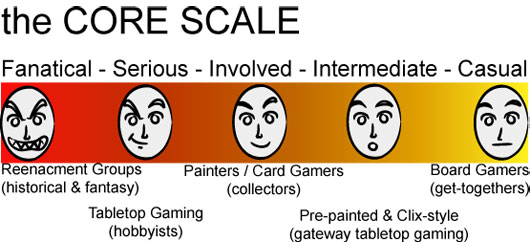
I drew out this map to show you the core scale of gamers. As you can imagine there is a little overlap. The majority of my blogs will be around the serious tabletop gamers but I will be sure to at least write a few lines on the other sections. Well except for the fanatics on the far left of the scale. People that are hardcore enough to get covered in tattoos of their favorite game (videogame or not), name their first born after a character or dress up every weekend to go out to play with other kooks are not for me.
The majority of the wargaming hobby is collecting, painting and customizing the models themselves. The most popular scale for miniatures ranges around 25-28 millimeters, about an inch for our non-metric friends. Years ago a majority of the characters used to be cast in lead. Lead is cheap, easy to mold, paint and customize. As you can imagine this raised health concerns so pewter and plastic eventually became the format of choice.
Some figures are solid pieces while larger ones or detailed ones have to be put together using an assortment of drills, pins and epoxy. Painting the figures takes a keen eye and a steady hand. Fine acrylics and ink washes began to be produced, some by the studios doing the modeling, as time went on these paints became better and higher quality. An entire industry came about just for the hobbyists. Once the figures were painted most gamers set about building landscape and architecture that complimented their army. This is the hobby component to tabletop gaming, the component that people do to relax and get away from the world for a while.
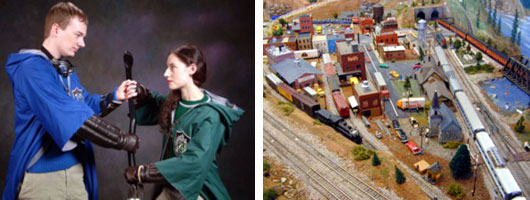
Look at the faces of model railroaders when they are running the trains through the dioramas they've worked so hard on. Their eyes gloss over and they seem to have found their "happy place." It comes as a sense of accomplishment. After lots of hard work it is something to take pride in. For good measure too, these are tangible things I am writing about. At the end of the day these hobbyists have something they can show off. A painted army, a row of trains, a tiny Hamlet. Videogames do not allow the same sense of accomplishment. Yes you can brag to your friends about your Level 75 shamanic-warrior-ninja-thief with enchanted Yuk-Yuk armor but it all goes away when you turn off the screen. There are a million gil farmers out there putting together the same characters and selling them on eBay. Miniatures are personal, individual, even if a handful end up on eBay.
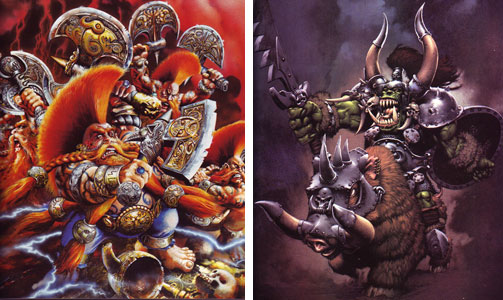
You don't have to be a great artist to paint miniatures either. Part of the hobby is enjoying the process and creating your own unique style. There are tons of resources online and in print. Never fear, I will drop links soon enough. There are articles that will walk you through the process of finding and building your own collection. I'll be here to talk about the various game systems if you are interested. So never fear, a community is out there ready to welcome you.
Tune in tomorrow to learn about the company that forever changed the world of gaming.

1 comment:
What is the begginning about its not really about role playnig? Brothers grimm aint role playing is it?
Post a Comment